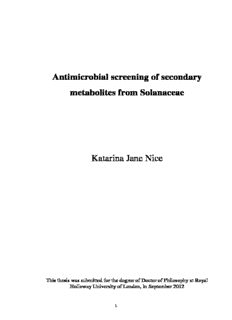
Antimicrobial screening of secondary metabolites from Solanaceae Katarina Jane Nice PDF
Preview Antimicrobial screening of secondary metabolites from Solanaceae Katarina Jane Nice
Antimicrobial screening of secondary metabolites from Solanaceae Katarina Jane Nice This thesis was submitted for the degree of Doctor of Philosophy at Royal Holloway University of London, in September 2012 1 Candidate declaration 2 Candidate declaration I declare that the work presented in this thesis is the original work of the author unless otherwise stated. Original material used in the creation of this thesis has not been previously submitted either in part or whole for a degree of any description from any institution. Katarina Nice …………………………………….. Katarina Nice 3 Abstract 4 Abstract The aim of the project was to analyse the potential antimicrobial activity of extracted secondary metabolites from wild tomato species, and other Solanaceous plants. The wild tomato species such as Solanum lycopersicum cv M82, Solanum cheesmaniae, Solanum chmielewskii, Solanum chilense, Solanum peruvianum, Solanum pimpinellifolium, Solanum pennellii, Solanum habrochaites, and Solanum neorickii were the primary focus of the project which were analysed for antimicrobial compounds. The hypothesis that the wild tomato relatives could be antimicrobial is linked to the insecticidal and fungicidal properties of several wild tomato relatives. This research is further supported by the previous findings into the antimicrobial potential of certain Solanaceae species, where the leaf tissue was noted to have the highest general antimicrobial activity. As part of this project the fully expanded undamaged leaves were examined for antimicrobial activity, after extracting the secondary metabolites in a range of solvents. Antimicrobial activity was determined through monitoring the plant extracts effect on the growth of gastroenteric bacteria Salmonella, Escherichia coli, and Staphylococcus aureus primarily through disc diffusion assays and growth curve analysis. The metabolomic profile of Staphylococcus aureus grown in the presence of identified antimicrobial Solanum pennellii extract was used to identify the compounds mode of action, and electron microscopy was used to view the effects of this extract upon the bacteria cell structure. Further putative identification of selected antimicrobial extracts was achieved through the use of thin layer chromatography, and gas chromatrography-mass spectrometry analysis. The Solanaceae plants which were identified to have a significant antimicrobial activity were Solanum habrochaites, Solanum pennellii, and Nicotiana rustica. The trichomes of these plants were identified as the primary target site for the production of these antimicrobial compounds. 5 Acknowledgements 6 Acknowledgements I would like to thank all my family and friends for their continued support and motivation during this period of my life. Particularly my best friend Emily Shell who is always there for me when I need her, my mother Jane Head for her enthusiastic encouragement, and my husband Sebastian Nice for his love and support. I would like to thank all my colleagues at the AHVLA and the RHUL who have aided me in this research, and who have trained me in specific laboratory techniques. With special thanks to Mary Bagnall, Emma Kennedy, Chris Gerrish, Dr. Daniel Rickett, Dr. Laura Perez-Fons, Dr. Michael Goodfellow, Dr. Matthew Jones, Dr. Leticia Mora, and Dr. Tom Wells, for your help and support. I would also like to thank Bill Cooley for performing the EM work, and I would like to thank Prof. Graham Seymour at the University of Nottingham for initially supplying plant material. I could not have completed this project without the financial support and resources from the Animal Health and Veterinary Laboratories Agency and the Royal Holloway which included a Thomas Holloway Scholarship. My supervisors have been fantastic, and I would like to thank them all sincerely; Prof. Roberto La Ragione for his sensible guidance, Prof. Peter Bramley for his advice and support, and particularly Dr. Paul Fraser for his confidence in me, and for allowing me to complete this research with creative freedom. I thank you all. 7 Dedication 8 Dedication This thesis is dedicated to my husband Sebastian Nice, because he has dedicated his life to me. In memory of Anakin. 9 List of Abbreviations Abs Absorbance ARB Antibiotic resistant bacteria ANOVA Analysis of variance AUC Area under the curve BCFAs Branched-chain fatty acids C Carbon c Celsius Ca Chlorophyll a Cb Chlorophyll b CDT Cytolethal distending toxin CBTols Cembratrienols CFU Colony forming unit CI Confidence interval CMV Cucumber mosaic virus cv Cultivar DPPC Dipalmitoylphosphatidycholine DHEC Diarrhoea-associated haemolytic DMS Dimethyl sulfide DMSO Dimethyl sulfoxide DAHP 3-deoxy-D-arabino-heptulosonate-7-phosphate synthase DNA Deoxyribonucleic acid DW Dry weight EPEC Enteropathogenic E. coli ESBIs Extended spectrum beta lactamases EHEC Enterohaemorrhagic E. coli EIEC Enteroinvasive E. coli ETEC Enterotoxigenic E. coli EaggEC Enteroaggregative ECM Extracellular matrix EM Electron microscopy EPS Exopolysaccharides ELISA Enzyme-linked immunosorbent assay FW Fresh weight GC-MS Gas chromatography-mass spectrometry HCL Hydrochloric acid HPLC-PDA High performance liquid chromatography-photodiode array HPLC High performance liquid chromatography h Hour HUS Haemolytic uremic syndrome KPT Potassium phosphotungstate ILs Introgression lines L Litre LB Luria broth LPS Lipopolysaccharide LC-MS Liquid chromatography-mass spectrometry LC-PDA-TOFMS Liquid chromatography-photodiode-array-time of flight-mass spectrometry MDR Multi drug resistant 10
Description: